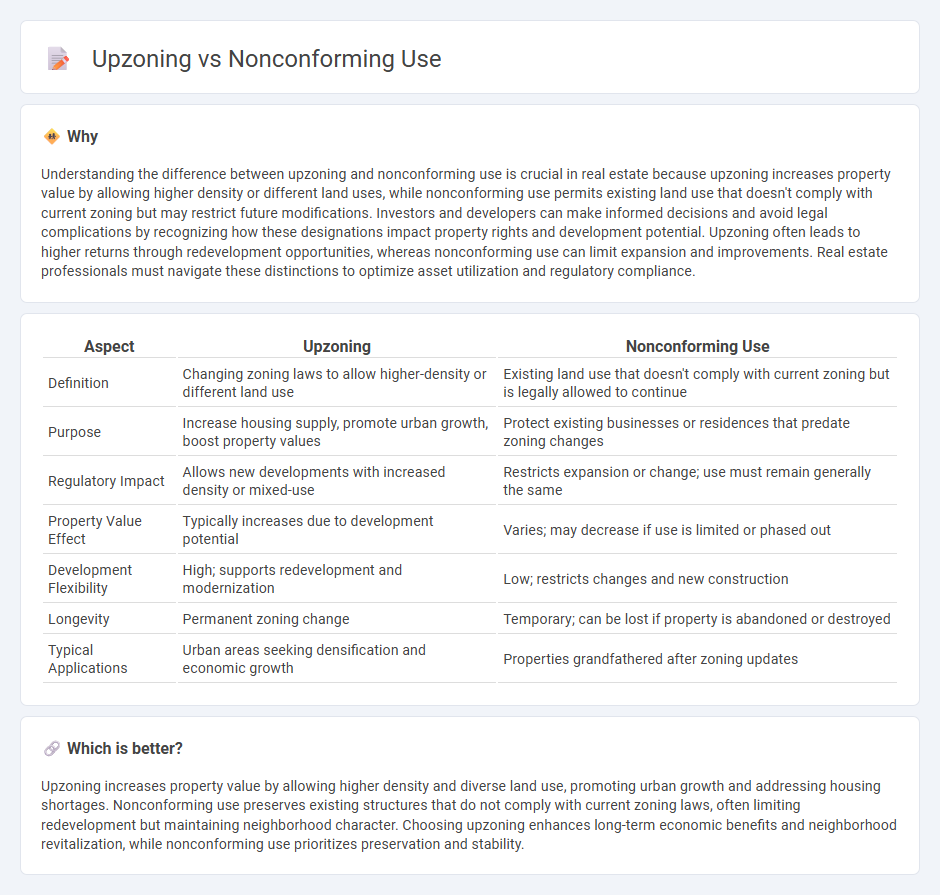
Upzoning allows for increased building density and height, promoting urban growth and higher property values by modifying zoning laws to permit more intensive land use in designated areas. Nonconforming use refers to existing properties or developments that do not comply with current zoning regulations but are allowed to continue due to prior approval or grandfathering provisions. Explore in-depth insights on how upzoning and nonconforming use impact real estate market dynamics and investment opportunities.
Why it is important
Understanding the difference between upzoning and nonconforming use is crucial in real estate because upzoning increases property value by allowing higher density or different land uses, while nonconforming use permits existing land use that doesn't comply with current zoning but may restrict future modifications. Investors and developers can make informed decisions and avoid legal complications by recognizing how these designations impact property rights and development potential. Upzoning often leads to higher returns through redevelopment opportunities, whereas nonconforming use can limit expansion and improvements. Real estate professionals must navigate these distinctions to optimize asset utilization and regulatory compliance.
Comparison Table
| Aspect | Upzoning | Nonconforming Use |
|---|---|---|
| Definition | Changing zoning laws to allow higher-density or different land use | Existing land use that doesn't comply with current zoning but is legally allowed to continue |
| Purpose | Increase housing supply, promote urban growth, boost property values | Protect existing businesses or residences that predate zoning changes |
| Regulatory Impact | Allows new developments with increased density or mixed-use | Restricts expansion or change; use must remain generally the same |
| Property Value Effect | Typically increases due to development potential | Varies; may decrease if use is limited or phased out |
| Development Flexibility | High; supports redevelopment and modernization | Low; restricts changes and new construction |
| Longevity | Permanent zoning change | Temporary; can be lost if property is abandoned or destroyed |
| Typical Applications | Urban areas seeking densification and economic growth | Properties grandfathered after zoning updates |
Which is better?
Upzoning increases property value by allowing higher density and diverse land use, promoting urban growth and addressing housing shortages. Nonconforming use preserves existing structures that do not comply with current zoning laws, often limiting redevelopment but maintaining neighborhood character. Choosing upzoning enhances long-term economic benefits and neighborhood revitalization, while nonconforming use prioritizes preservation and stability.
Connection
Upzoning allows for increased density or different land uses in a zoning district, which can conflict with existing nonconforming uses that were lawful before the zoning change but do not comply with new regulations. Nonconforming use provisions protect these pre-existing uses, permitting them to continue despite the upzoning. This connection often leads to legal and development challenges as municipalities balance growth objectives with property rights.
Key Terms
Zoning Ordinance
Nonconforming use refers to the continued utilization of land or structures that do not comply with current zoning regulations but were lawful at the time established, while upzoning involves changing zoning ordinances to allow for higher density or different land uses. Zoning ordinances dictate land use regulations, and understanding the distinction between nonconforming use protections and upzoning benefits is essential for property owners and developers navigating land development. Explore zoning ordinance nuances to better manage property rights and development opportunities.
Grandfather Clause
Nonconforming use refers to properties that legally existed under previous zoning regulations but no longer comply with current zoning laws, often protected by the Grandfather Clause to continue their use without penalty. Upzoning involves changing zoning laws to allow more intensive land use, such as higher density or different building types, which can affect property values and development rights but typically does not override nonconforming use rights. Explore the implications of the Grandfather Clause in urban planning and development for a deeper understanding of zoning dynamics.
Land Use Regulations
Nonconforming use refers to an existing land use that does not comply with current zoning regulations but is permitted to continue due to prior approval, while upzoning involves modifying zoning laws to allow higher density or more intensive land uses in a designated area. Land use regulations address how property can be developed or used, with nonconforming uses often facing restrictions on expansion or alterations, and upzoning encouraging redevelopment and increased urban density. Explore detailed insights into how nonconforming use and upzoning impact land development strategies and regulatory compliance.
Source and External Links
What Does Non-Conforming Use Mean in Real Estate Law? - A non-conforming use is a use of land or property that does not comply with current zoning laws but is allowed to continue under specific conditions, often because it was legally established before new zoning regulations took effect.
Understanding Nonconforming Use in Property Zoning - Nonconforming use refers to a property's use that differs from current zoning rules, with legal nonconforming uses being "grandfathered" from previous law and illegal nonconforming uses subject to enforcement actions.
nonconforming use | Wex - Law.Cornell.Edu - Nonconforming use allows properties that existed before new zoning laws to continue under exemptions, typically barring expansion or new nonconforming uses, often with time limits for compliance.
 dowidth.com
dowidth.com